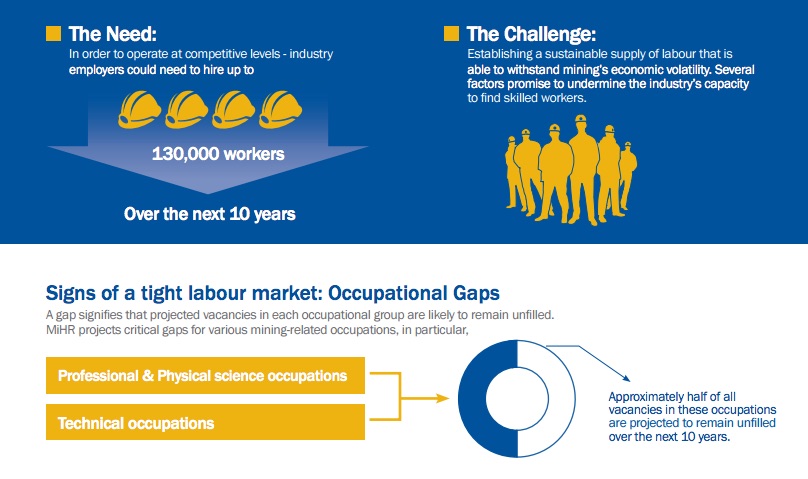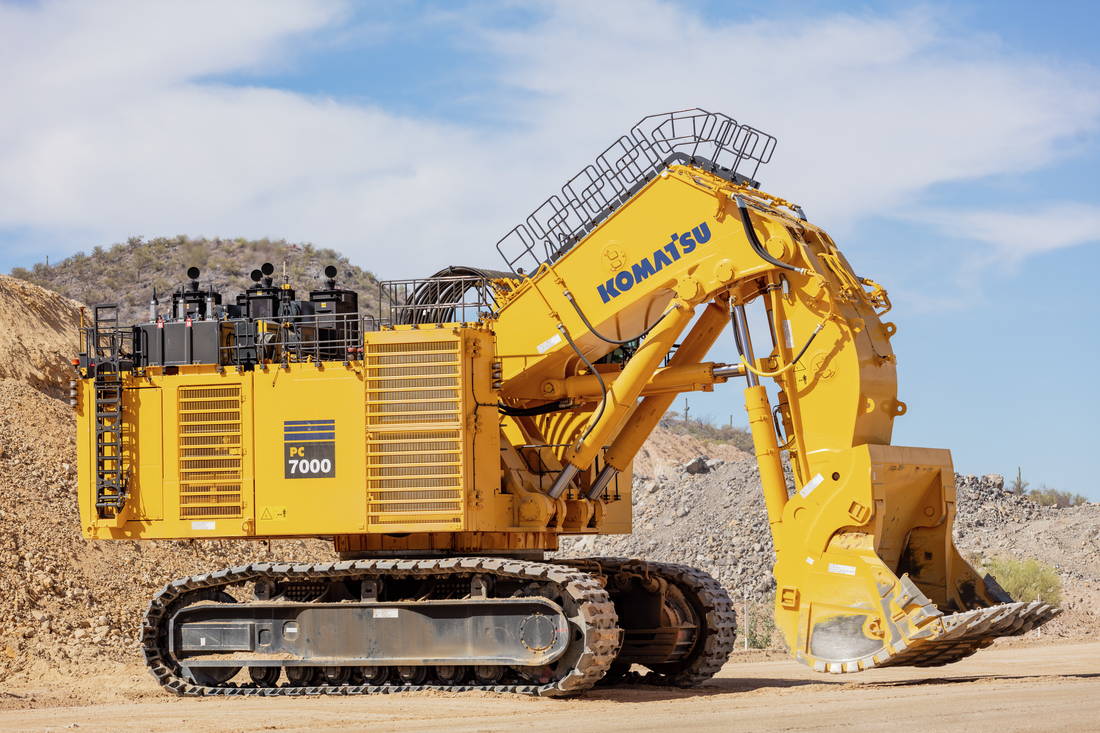Mining jobs in Canada to go begging: MiHR report

A torrent of retirements over the next 10 years is poised to wreak havoc on the mining labour market in Canada.
While the unemployment rate in mining, quarrying and oil and gas has improved in 2017 from the summer of 2016 – from 10% to 7% – the next decade is going to be challenging for the industry as it seeks to replace older workers who are turning in their coveralls and enjoying their golden years. So says a new report from the Mining Industry Human Resources Council (MiHR), which projects 87,830 workers will need to be hired over the next decade under a baseline scenario. If mining expands, the need for miners and associated professions climbs to 130,410, and under a contraction, shrinks to 43,200.
“One of the most significant challenges facing Canada’s mining industry is establishing a sustainable supply of labour that is able to withstand the economic volatility that characterizes the sector”: Mining Industry Human Resources Council report
“One of the most significant challenges facing Canada’s mining industry is establishing a sustainable supply of labour that is able to withstand the economic volatility that characterizes the sector,” notes the report. The report suggests that there will be a 47% gap (demand exceeds supply) for technical occupations, 56% for supervisors and foremen, 18% for skilled trades and 10% for production workers.
According to MiHR’s forecasts, the industry will need to hire roughly 18,210 people in these occupations from 2018 to 2027, but is only expected to secure 8,670 new entrants, leaving a total gap of 9,540 – meaning about half of all vacancies will go unfilled.
“This poses a significant risk to mining operations, given that a thin labour supply has the potential to derail projects, drive up the cost of finding workers and ultimately undermine an operation’s ability to run competitively,” reads an executive summary of the report.
That obviously calls for a new generation in mining, with key education programs needed to improve the labour supply.
“The incoming generation of new entrants are vitally important to the health of mining’s future labour supply, especially prospective students,” says the report.
It noted nearly half (47%) of hiring requirements will be met by retiring workers, which places a significant burden on employers.
“Each retiree takes with them a unique set of skills and knowledge, and those leaving with experience create a void that is difficult to fill,” says MiHR.
Factors exacerbating the tight mining labour market include:
- Age and retirement: Older workers have surged from 11 per cent in 2007 to 16 per cent in 2016, while younger workers have dropped from 13 per cent to 5 per cent over that same period.
- Lack of gender parity: While women represent nearly half of the Canadian labour force, they make up only about 19 per cent of the labour force in mining.
- Economic volatility: economic downturns and upswings result in widely fluctuating demand for labour and this instability can affect a mining employer’s ability to secure labour.
- Remoteness: Mining operations often exist in remote parts of the country with extremely low populations lacking skills. It is common for employers to source workers from other regions of Canada.
{{ commodity.name }}
{{ post.title }}
{{ post.date }}


13 Comments
Mark
The HR people just need to start picking up the phone and hiring. Canada has an engineering underemployment/unemployment crisis, with 2/3rds of Canadian engineers not able to find field-relevant employment. Of course, mines in remote locations may need to pay a significant premium for top-tier professionals, instead of the current practice of compensating head office accountants and lawyers more highly than engineers.
krusty1234
You’re quite right there. If, as the article alleges, that there is and will be sctreaming demand, the pay scale in some mining professions has absolutely collapsed. Some operations are paying salaries/contract rates experienced in the late eighties.
With today’s cost of living, it’s easier to stay closer to home and get work in another sector.
Nitish Dobhal
I am a mining graduate currently on work permit. This report on job prospects doesnt fit well with my personal experience in last 4 years. My batchmates have shared the same experience during the coops and then fulltime job applications. Online application has been of zero value for quite a while now. Only way to get a job is through a personal contacts.
For postgrad immigrants like me it is a particularly difficult as it presents a conundrum of staying in mining or seeking other avenues, with time being a factor.
All in all, the statement that ‘there will be a shortage of mining professionals’ has stayed for quite a while inspite of being quite inaccurate.
Nordbird
“Economic volatility: economic downturns and upswings result in widely fluctuating demand for labour and this instability can affect a mining employer’s ability to secure labour”.
When mining people get laid off during an economic downturn, they go into other industries, and never return.
For example, a mine manager has the same skill set required to successfully run a port facility, but trying to get a port manager to run a mine is ridiculous.
Scott
There needs to be some pragmatism from the mining companies here too. Instead of just firing / retrenching as many people as possible as soon as the price of any commodity looks like it might fall, invest in keeping those workers so they are in a good place to manage the upcycle. Too many people have to change industries and lose their skills when miners just fire swathes of them in the name of “cost cutting”. It’s a false economy, all they’re doing is ensuring they’ll need to pay over the odds for workers when the price turns and ensuring there are fewer of them.
LAMB
The Mining Industry has got to stop retiring it’s Managers just for the sake of “retiring”. They would be well advised to keep these skilled managers on the payroll to train THE YOUNGER GUYS AND PASS ON THEIR EXPERTISE. Today, WE SEE YOUNG GUYS REPLACING SENIOR MANAGERS and failing BECAUSE THEY DO NOT HAVE THE EXPERIENCE TO MAKE THE RIGHT DECISION. There has been a tendency to retire Senior Managers in order to “Save Money” during a market downturn – but when the market regains it’s strength, the young managers fail .
Many senior managers are moving into other industries or making their expertise available through CONSULTING, hence the Mining Industry loses the expertise that they paid for over the years. This is MAINLY because the CEO is now an ACCOUNTANT and has NO Knowledge of what makes a successful company – they just think it is “the bottom line” that matters – and the BOARD, made up of the same people inexperienced in MINING, support these BAD DECISIONS.
Timothy Boateng
They should go on and train the young ones, I hope something good will come out from it.
adam
Canadian mining companies could start hiring fewer Canadians at their mines in the US, and have more potential hirees domestically.
Timothy Boateng
Experience people are here too in Africa (Ghana) not only Europe.
Uramin
From my observation, the situation is completely different to what this article states. In fact, mining graduates cannot find a job being forced to change their occupation to bus drivers, real estate agents, etc. “If mining expands, the need for miners and associated professions climbs to 130,410, and under a contraction, shrinks to 43,200” – the pessimistic scenario is more real, as usual.
Yudi Antoro
I,d say pay your miner well then they will not leaving canada and work at another countries, and big tax doesnt help also.
Jan Kruger
Where can one apply to be able to fill these positions that will become available ?
Nakul Jain
This report ruthlessly gives false optimism to prospects. Having experienced this struggle first hand through countless job applications, networking and all such avenues with a constant grind at it since 2013, I along with many mining grads feel undervalued especially as international students who carry huge financial burdens on top of the joys of living far away from home. I have engineering degrees from top American and Canadian schools, always been in top 10% of my classes, always in the 95% percentile in any standardized exam like SAT’s (I am no dummy), got 4 relevant co-op experiences before graduating and currently work in waterworks still trying to make use of my education yet the idea of finding even a non-technical role in the mining industry still seems remote. I observed 4 graduating classes from 2013-2017 to have less than 10% placement rates from a top mining school. No sane person would choose mining if they are made aware of the real pitfalls of this industry. Easier said than done, ” hang in there “, why, for how long and does that make sense? Finance, data science, programming are just 3 of many fields that would gladly accept engineers with opportunities to make 6 figure salaries and work in urban environments without needing to periodically plan for the next downturn.